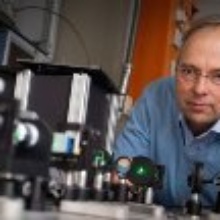The end of classical microelectronics is on the horizon. The transition to nanoelectronics will require new approaches based on quantum-physical effects. The Interdisciplinary Center for Applied Quantum Technology (ZAQuant) will be built in the next few years at the University of Stuttgart to bring physics, the engineering sciences, and industry together for joint research into new kinds of quantum sensors and their development into useable prototypes.
Back then, it looked more like a bent paper clip with a piece of germanium at each end than an electronic microprocessor component. But that first industrially useable transistor, presented publicly by Bell Lab scientists in 1947, launched the triumphant advance of the computer. Back then, the transistor easily filled the palm of a hand. Now, just 70 years later, transistors can be miniaturized and integrated so small that a smartwatch on the wrist contains a processor with roughly a billion transistors. Such a processor can stream videos in TV-quality on the smartwatch.
When Professor Harald Gießen, Director of the University of Stuttgart's 4th Institute of Physics, talks about the up-and-coming changeover from microelectronics to quantum technology, he likes to use the last 70 years for comparison in order to make it clear where development stands today: "The Bell Lab transistor had a capacity of one bit: On-and-Off; that is possible today in the quantum world as well." However, this bit-analogon, called the "Qubit", comprises more, namely the two states of On-Off and all overlays of the two extremes. And there's still another difference: Generating this Qubit requires a complex laboratory setup which appears to be at least as bulky as the transistor of 1947. "The mid-1960s saw the first electronic switching circuits with perhaps ten or twenty transistors - we can't yet do that today with Qubits, not even in the laboratory," continues physicist Gießen. Not to mention the triumphant advent of the transistor radio or the first microchip-based processors in the 1970s. "So we're now standing in quantum technology somewhere between 1947 and the 1960s." In other words: still almost at the beginning....
Please follow the link for the full article...


